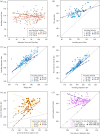A range-wide domino effect and resetting of the annual cycle in a migratory songbird
- PMID: 30963870
- PMCID: PMC6367182
- DOI: 10.1098/rspb.2018.1916
A range-wide domino effect and resetting of the annual cycle in a migratory songbird
Abstract
Latitudinal differences in timing of breeding are well documented but how such differences carry over to influence timing of events in the annual cycle of migratory birds is not well understood. We examined geographical variation in timing of events throughout the year using light-level geolocator tracking data from 133 migratory tree swallows ( Tachycineta bicolor) originating from 12 North American breeding populations. A swallow's breeding latitude influenced timing of breeding, which then carried over to affect breeding ground departure. This resulted in subsequent effects on the arrival and departure schedules at autumn stopover locations and timing of arrival at non-breeding locations. This 'domino effect' between timing events was no longer apparent by the time individuals departed for spring migration. Our range-wide analysis demonstrates the lasting impact breeding latitude can have on migration schedules but also highlights how such timing relationships can reset when individuals reside at non-breeding sites for extended periods of time.
Keywords: Tachycineta bicolor; carry-over effects; life history; migration; timing of breeding; tree swallow.
Conflict of interest statement
We declare we have no competing interests.
Figures



References
-
- Slagsvold T. 1976. Annual and geographical variation in the time of breeding of the great tit Parus major and the pied flycatcher Ficedula hypoleuca in relation to environmental phenology and spring temperature. Ornis Scand. 7, 127–145. (10.2307/3676183) - DOI
Publication types
MeSH terms
Associated data
LinkOut - more resources
Full Text Sources
Other Literature Sources
